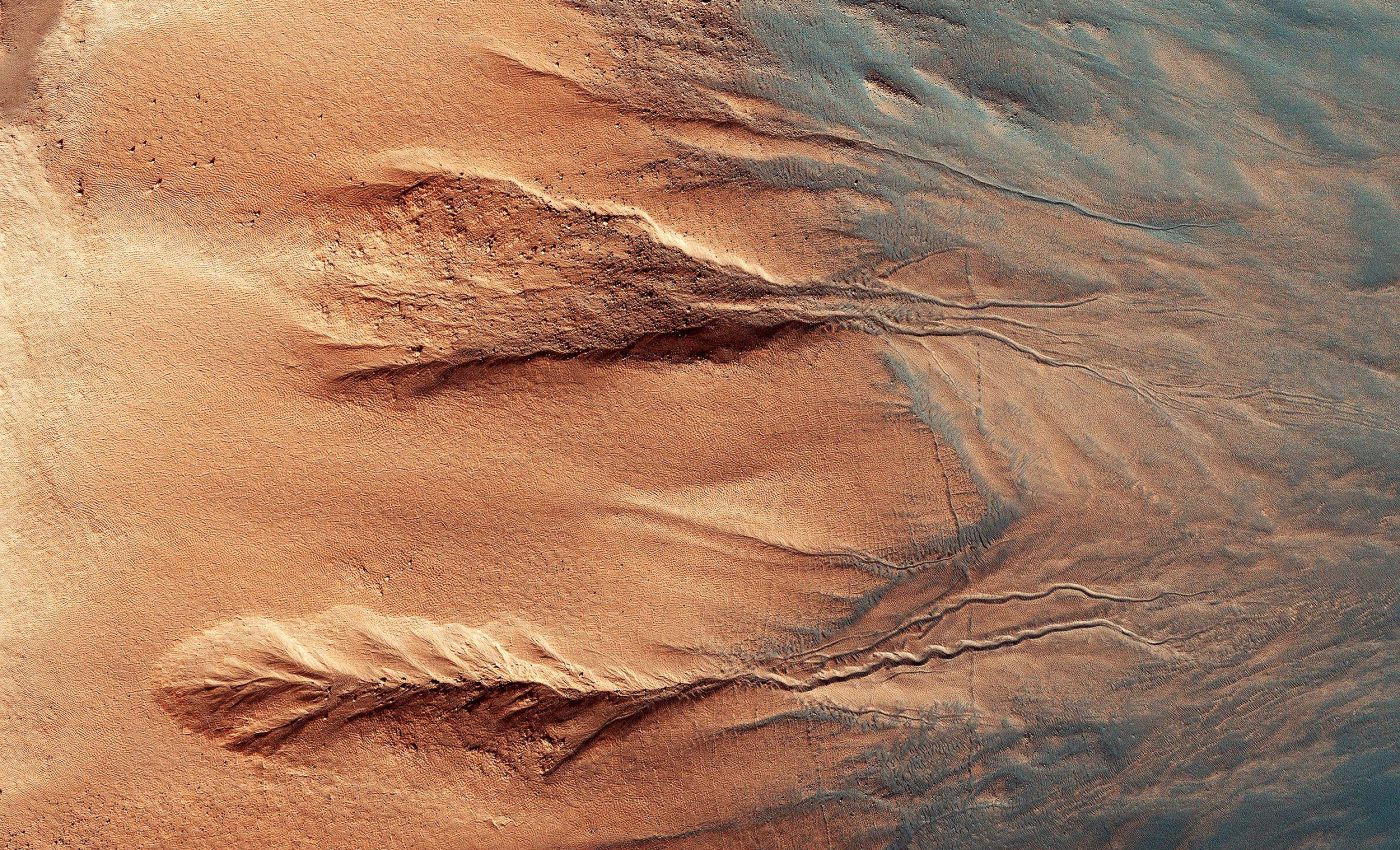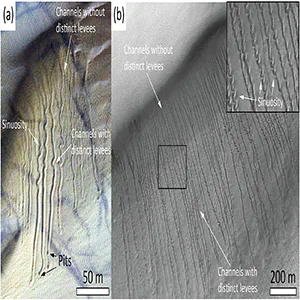
Mars is covered with gullies, but no one is sure what created them
When scientists first spotted long, narrow gullies carved into the sand dunes of Mars, some believed they could be signs of past life – or at least of flowing water.
That hope has fizzled for now. But it turns out something else entirely may be responsible for shaping these alien features: exploding dry ice.
That’s right – dry ice may be carving up the Martian landscape in ways we’ve never seen happen on Earth.
Lots of gullies on Mars
Mars has a reputation for being cold, dry, and dusty. But it’s also home to some surprising terrain.
Across parts of the Red Planet, especially in its southern hemisphere, the slopes of sandy dunes are etched with deep, winding gullies.
At first glance, these gullies on Mars look like they were made at by flowing water, maybe even something like melting snow or underground springs. But Mars is too cold and dry for that, especially now.
Temperatures in some places can drop to minus 190°F (minus 123°C) during the winter. That rules out liquid water – at least for most of the time.
Still, something had to be digging out those long tracks.
When dry ice becomes a bulldozer
Scientists have long wondered if carbon dioxide (CO₂) ice – also called dry ice – could be involved.
The thin, Martian atmosphere is made mostly of CO₂ and, during the winter, it freezes and coats the surface like frost. As spring arrives, it warms up fast.
When this CO₂ ice sits on warmer sand, it doesn’t melt. It goes straight from solid to gas, a process called sublimation. That’s where things get interesting.
In a recent lab experiment, researchers found that CO₂ ice blocks – some as big as 3 feet (0.9 meters) long – can actually dig into sand and slide downhill on a layer of gas.
As the bottom of the block sublimates, the gas has nowhere to go. Pressure builds up. Then . . . boom! The gas shoots out, blasting sand in all directions.
Dry ice and Mars’ gullies
“In our simulation, I saw how this high gas pressure blasts away the sand around the block in all directions,” said Earth scientist Dr. Lonneke Roelofs from Utrecht University.
The escaping gas carved out a pit around the block, pushing sand to the sides and helping the block burrow deeper into the slope.
But the process doesn’t stop there. As the block keeps turning to gas, it keeps pushing against the ground, slowly scooting its way down the slope and leaving behind a long, narrow gully edged with ridges of sand. This matches what scientists see on Mars.

Hunting for answers
To test this out, Roelofs teamed up with master’s student Simone Visschers and traveled to Milton Keynes in England.
There, the Open University has a “Mars chamber” – a sealed space where researchers can simulate Martian conditions like temperature and atmospheric pressure.
They tried different slope angles and dropped CO₂ ice blocks from the top. After a few attempts, things clicked.
“After finding the right slope, we finally saw results. The CO2 ice block began to dig into the slope and move downwards, just like a burrowing mole or the sandworms from Dune. It looked very strange!” commented Visschers.
This was the first time anyone had ever observed dry ice behaving this way – blasting through sand like a living creature. It’s a process that doesn’t happen naturally on Earth, because we don’t have the right conditions.
Where is the dry ice from?
The CO₂ ice blocks form during the Martian winter, when a thick layer of dry ice – up to 28 inches (70 centimeters) – spreads across entire dune fields. As spring warms things up, most of the ice sublimates.
But the last remaining patches, often on the shady sides of dunes, can break off and tumble down.
Once these blocks hit the slope, the warmer sand triggers more sublimation. The blocks move downhill, powered by the escaping gas. Eventually, the CO₂ fully turns into gas, leaving behind a gully in the sand.
Mars, Earth, and the big questions
So, what’s the point of studying all this?
“Mars is our nearest neighbour. It is the only rocky planet close to the ‘green zone’ of our solar system. This zone lies exactly far enough from the Sun to make the presence of liquid water possible, which is a prerequisite for life,” explained Roelofs.
Because of this, it would be possible to study and answer questions about the origin of life, and possible extra-terrestrial life, here on Mars.
“Also, conducting research into the formation of landscape structures of other planets is a way of stepping outside the frameworks used to think about the Earth. This allows you to pose slightly different questions, which in turn can deliver new insights for processes here on our planet.”
For now, Martian gullies don’t mean aliens or even past water. But they do offer a glimpse into a very different kind of geology – one shaped by a type of ice we barely think about, acting in ways we’ve never seen before.
The full study was published in the journal Geophysical Research Letters.
Image credit: NASA/JPL-Caltech/MSSS
—–
Like what you read? Subscribe to our newsletter for engaging articles, exclusive content, and the latest updates.
Check us out on EarthSnap, a free app brought to you by Eric Ralls and Earth.com.
—–













